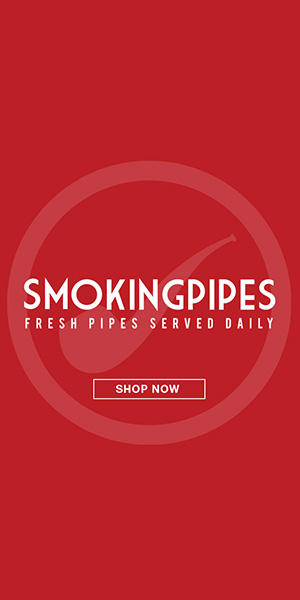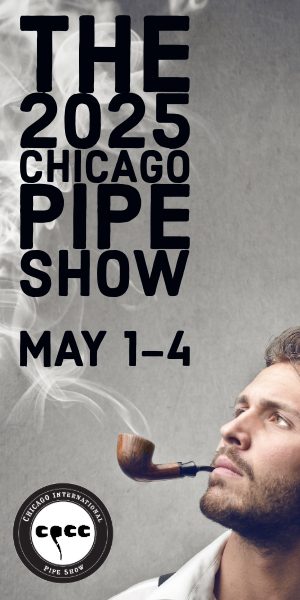Casing vs Topping?
- Thread starter AlanH
- Start date
You are using an out of date browser. It may not display this or other websites correctly.
You should upgrade or use an alternative browser.
You should upgrade or use an alternative browser.
SmokingPipes.com Updates
Watch for Updates Twice a Week
Casings are applied early on in the tobacco blending process and is meant to try to keep blends consistent with different tasting leaf from different years harvests. They also add proprietary flavors that brand blends with a company, and add a touch of something else, whatever you make of that.
Toppings are added later in the process and are meant to add a whole new flavor to the blend that is not natural to tobacco.
However, some casings are stronger than some toppings, but in the industry, when it’s applied and the intentions of the application differentiates them.
I hope that helps.
Toppings are added later in the process and are meant to add a whole new flavor to the blend that is not natural to tobacco.
However, some casings are stronger than some toppings, but in the industry, when it’s applied and the intentions of the application differentiates them.
I hope that helps.
From G.L. Pease :
"Q: I keep hearing about "cased" tobacco. What does this mean?
A: There are two things of interest here, namely "casing" and "top flavouring." They are two distinctly different approaches to altering a blend's flavor. Some tobaccos employ both.
Casing requires that the tobacco be soaked in or sprayed with a "sauce" that may contain sugar, molasses, liquorice, alcohols like rum or whiskey, and various flavourings, natural or otherwise, depending on the manufacturer. Once the tobacco "drinks" the sauce, it's conditioned in large cylinders that dry it back to the desired moisture level, generally between 12% (on the dry side) and 22% (very moist). Optimal moisture for smoking depends on the smoker, but it's generally in the 13-16% range. The aromas and flavours imparted by casing will remain in the tobacco pretty tenaciously, and will affect the smoke throughout the bowl.
Top-flavouring is added by spraying the finished blend with scents and flavourings. This is usually a much lighter application, and doesn't alter the moisture content of the leaf dramatically. Sometimes called "top-notes," this can be quite ephemeral. Because of the volatile nature of many of the commonly used components, a tobacco left to "air out" may lose a lot of the perfume that's applied this way.
Depending on the casing used, tobaccos can become very sticky. Some producers use humectants to maintain a specific moisture level in the final product. You'll hear people talk about PG, or propylene glycol, the most commonly used humectant these days. It's generally spoken of in rather disparaging terms, thought it's not the PG that deserves the condmenation, but the blending houses who use it with reckless abandon. If the tobacco won't dry out, PG is likely the culprit. In small quantities, it does its job well. In large quantities, it produces a sticky, wet smoking, pipe clogging weed that should never see the inside of a pipe.
Not all flavoured tobaccos are cased, and casing is not always a bad thing, but the term is used incorrectly more often than not, so a lot of confusion has been created."
"Q: I keep hearing about "cased" tobacco. What does this mean?
A: There are two things of interest here, namely "casing" and "top flavouring." They are two distinctly different approaches to altering a blend's flavor. Some tobaccos employ both.
Casing requires that the tobacco be soaked in or sprayed with a "sauce" that may contain sugar, molasses, liquorice, alcohols like rum or whiskey, and various flavourings, natural or otherwise, depending on the manufacturer. Once the tobacco "drinks" the sauce, it's conditioned in large cylinders that dry it back to the desired moisture level, generally between 12% (on the dry side) and 22% (very moist). Optimal moisture for smoking depends on the smoker, but it's generally in the 13-16% range. The aromas and flavours imparted by casing will remain in the tobacco pretty tenaciously, and will affect the smoke throughout the bowl.
Top-flavouring is added by spraying the finished blend with scents and flavourings. This is usually a much lighter application, and doesn't alter the moisture content of the leaf dramatically. Sometimes called "top-notes," this can be quite ephemeral. Because of the volatile nature of many of the commonly used components, a tobacco left to "air out" may lose a lot of the perfume that's applied this way.
Depending on the casing used, tobaccos can become very sticky. Some producers use humectants to maintain a specific moisture level in the final product. You'll hear people talk about PG, or propylene glycol, the most commonly used humectant these days. It's generally spoken of in rather disparaging terms, thought it's not the PG that deserves the condmenation, but the blending houses who use it with reckless abandon. If the tobacco won't dry out, PG is likely the culprit. In small quantities, it does its job well. In large quantities, it produces a sticky, wet smoking, pipe clogging weed that should never see the inside of a pipe.
Not all flavoured tobaccos are cased, and casing is not always a bad thing, but the term is used incorrectly more often than not, so a lot of confusion has been created."
Very helpful thank you!From G.L. Pease :
"Q: I keep hearing about "cased" tobacco. What does this mean?
A: There are two things of interest here, namely "casing" and "top flavouring." They are two distinctly different approaches to altering a blend's flavor. Some tobaccos employ both.
Casing requires that the tobacco be soaked in or sprayed with a "sauce" that may contain sugar, molasses, liquorice, alcohols like rum or whiskey, and various flavourings, natural or otherwise, depending on the manufacturer. Once the tobacco "drinks" the sauce, it's conditioned in large cylinders that dry it back to the desired moisture level, generally between 12% (on the dry side) and 22% (very moist). Optimal moisture for smoking depends on the smoker, but it's generally in the 13-16% range. The aromas and flavours imparted by casing will remain in the tobacco pretty tenaciously, and will affect the smoke throughout the bowl.
Top-flavouring is added by spraying the finished blend with scents and flavourings. This is usually a much lighter application, and doesn't alter the moisture content of the leaf dramatically. Sometimes called "top-notes," this can be quite ephemeral. Because of the volatile nature of many of the commonly used components, a tobacco left to "air out" may lose a lot of the perfume that's applied this way.
Depending on the casing used, tobaccos can become very sticky. Some producers use humectants to maintain a specific moisture level in the final product. You'll hear people talk about PG, or propylene glycol, the most commonly used humectant these days. It's generally spoken of in rather disparaging terms, thought it's not the PG that deserves the condmenation, but the blending houses who use it with reckless abandon. If the tobacco won't dry out, PG is likely the culprit. In small quantities, it does its job well. In large quantities, it produces a sticky, wet smoking, pipe clogging weed that should never see the inside of a pipe.
Not all flavoured tobaccos are cased, and casing is not always a bad thing, but the term is used incorrectly more often than not, so a lot of confusion has been created."
I figured you might know about this being a grower. I guess It is difficult to know then what different companies use as casing? Seems I remember you saying you did not like the casing of one company. For most unflavored tobaccos like a straight Virginia or a burly what would be primarily used as casing by most companies? Thank you so much for your response very helpful.From G.L. Pease :
"Q: I keep hearing about "cased" tobacco. What does this mean?
A: There are two things of interest here, namely "casing" and "top flavouring." They are two distinctly different approaches to altering a blend's flavor. Some tobaccos employ both.
Casing requires that the tobacco be soaked in or sprayed with a "sauce" that may contain sugar, molasses, liquorice, alcohols like rum or whiskey, and various flavourings, natural or otherwise, depending on the manufacturer. Once the tobacco "drinks" the sauce, it's conditioned in large cylinders that dry it back to the desired moisture level, generally between 12% (on the dry side) and 22% (very moist). Optimal moisture for smoking depends on the smoker, but it's generally in the 13-16% range. The aromas and flavours imparted by casing will remain in the tobacco pretty tenaciously, and will affect the smoke throughout the bowl.
Top-flavouring is added by spraying the finished blend with scents and flavourings. This is usually a much lighter application, and doesn't alter the moisture content of the leaf dramatically. Sometimes called "top-notes," this can be quite ephemeral. Because of the volatile nature of many of the commonly used components, a tobacco left to "air out" may lose a lot of the perfume that's applied this way.
Depending on the casing used, tobaccos can become very sticky. Some producers use humectants to maintain a specific moisture level in the final product. You'll hear people talk about PG, or propylene glycol, the most commonly used humectant these days. It's generally spoken of in rather disparaging terms, thought it's not the PG that deserves the condmenation, but the blending houses who use it with reckless abandon. If the tobacco won't dry out, PG is likely the culprit. In small quantities, it does its job well. In large quantities, it produces a sticky, wet smoking, pipe clogging weed that should never see the inside of a pipe.
Not all flavoured tobaccos are cased, and casing is not always a bad thing, but the term is used incorrectly more often than not, so a lot of confusion has been created."
Sounds like you're talking about Michael (cosmicfolklore) who posted before me. Casings don't bother me.I figured you might know about this being a grower. I guess It is difficult to know then what different companies use as casing? Seems I remember you saying you did not like the casing of one company. For most unflavored tobaccos like a straight Virginia or a burly what would be primarily used as casing by most companies? Thank you so much for your response very helpful.
Oops meant this for you sir.Casings are applied early on in the tobacco blending process and is meant to try to keep blends consistent with different tasting leaf from different years harvests. They also add proprietary flavors that brand blends with a company, and add a touch of something else, whatever you make of that.
Toppings are added later in the process and are meant to add a whole new flavor to the blend that is not natural to tobacco.
However, some casings are stronger than some toppings, but in the industry, when it’s applied and the intentions of the application differentiates them.
I hope that helps.
I figured you might know about this being a grower. I guess It is difficult to know then what different companies use as casing? Seems I remember you saying you did not like the casing of one company. For most unflavored tobaccos like a straight Virginia or a burly what would be primarily used as casing by most companies? Thank you so much for your response very helpful.
Oops you are right ? thank you for your response.Sounds like you're talking about Michael (cosmicfolklore) who posted before me. Casings don't bother me.
All I know from what I posted above, comes from listening to guys like Russ Ouellette, when he was active on here.Oops meant this for you sir.
I figured you might know about this being a grower. I guess It is difficult to know then what different companies use as casing? Seems I remember you saying you did not like the casing of one company. For most unflavored tobaccos like a straight Virginia or a burly what would be primarily used as casing by most companies? Thank you so much for your response very helpful.
An actual tobacconist, would be better at answering this, like @jeremyreeves
My first few years of growing… actually a couple of years after that because of the time it took to get to the blending stage, but anyways… I first thought that I “had” to add a cassing. I was thinking mold, and slowing the burn…. But, really, I found I just preferred smoking it without any of that. So, I just blend with natural tobacco. That in no way makes me knowledgeable on what exactly used by companies.
Jeremy could probably give you the best answer. One of the things I love about most C&D blends is the way he adds whatever he’s added, but it hardly interferes with the tobacco taste. My favorites by them, has me guessing that nothing at all has been added. That’s an artist.
Greg Pease is a’ight too.

from my understanding it's just when and how it's applied. Lots of mostly this and mostly thats going on. But it's soaked or covered with. Think sauce versus marinate.
In the case of stoving or steaming tobacco, casing is usually added before this process and topping added after. Casings and toppings can sometimes be the same thing just applied at different times for different effect.
many many blends have some form of sweetener like sugar, honey, maple syrup, molasses. Alcohols like bourbon or rum are commonly added and can sweeten things up too.
various herbs can be infused into liquid or extracted into alcohol or as an essential oil. Obvious ones like vanilla, chocolate and Tonka beans but also wintergreen, bergamot, jasmine, lavender, benzoin, rose geranium and other essential oils. Also fruit juices or extracts can be used too. Plum is common with Virginia. many burleys will get some molasses and/or chocolate.
many many blends have some form of sweetener like sugar, honey, maple syrup, molasses. Alcohols like bourbon or rum are commonly added and can sweeten things up too.
various herbs can be infused into liquid or extracted into alcohol or as an essential oil. Obvious ones like vanilla, chocolate and Tonka beans but also wintergreen, bergamot, jasmine, lavender, benzoin, rose geranium and other essential oils. Also fruit juices or extracts can be used too. Plum is common with Virginia. many burleys will get some molasses and/or chocolate.








